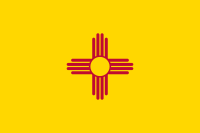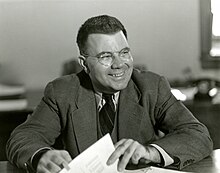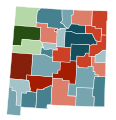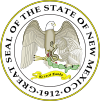The New Mexico Portal New Mexico (Spanish: Nuevo México [ˈnweβo ˈmexiko] ⓘ; Navajo: Yootó Hahoodzo Navajo pronunciation: [jòːtʰó hɑ̀hòːtsò]) is a landlocked state in the Southwestern region of the United States. It is one of the Mountain States of the southern Rocky Mountains, sharing the Four Corners region with Utah, Colorado, and Arizona. It also borders Texas to the east and southeast, Oklahoma to the northeast, and the Mexican states of Chihuahua and Sonora to the south. New Mexico's largest city is Albuquerque, and its state capital is Santa Fe, the oldest state capital in the U.S., founded in 1610 as the government seat of Nuevo México in New Spain. New Mexico is the fifth largest of the fifty states by area, but with just over 2.1 million residents, ranks 36th in population and 46th in population density. Its climate and geography are highly varied, ranging from forested mountains to sparse deserts; the northern and eastern regions exhibit a colder alpine climate, while the west and south are warmer and more arid. The Rio Grande and its fertile valley runs from north-to-south, creating a riparian climate through the center of the state that supports a bosque habitat and distinct Albuquerque Basin climate. One–third of New Mexico's land is federally owned, and the state hosts many protected wilderness areas and national monuments, including three UNESCO World Heritage Sites, the most of any U.S. state. New Mexico's economy is highly diversified, including cattle ranching, agriculture, lumber, scientific and technological research, tourism, and the arts, especially textiles and visual arts. Major sectors include mining, oil and gas, aerospace, media, and film. Its total gross domestic product (GDP) in 2020 was $95.73 billion, with a GDP per capita of roughly $46,300. State tax policy is characterized by low to moderate taxation of resident personal income by national standards, with tax credits, exemptions, and special considerations for military personnel and favorable industries. Due to its large area and economic climate, New Mexico has a significant U.S. military presence, including White Sands Missile Range, and strategically valuable federal research centers, such as the Sandia and Los Alamos National Laboratories. The state hosted several key facilities of the Manhattan Project, which developed the world's first atomic bomb, and was the site of the first nuclear test, Trinity. (Full article...) Entries here consist of Good and Featured articles, which meet a core set of high editorial standards.
Edward Uhler Condon (March 2, 1902 – March 26, 1974) was an American nuclear physicist, a pioneer in quantum mechanics, and a participant during World War II in the development of radar and, very briefly, of nuclear weapons as part of the Manhattan Project. The Franck–Condon principle and the Slater–Condon rules are co-named after him. He was the director of the National Bureau of Standards (now NIST) from 1945 to 1951. In 1946, Condon was president of the American Physical Society, and in 1953 was president of the American Association for the Advancement of Science. (Full article...)Selected article -U.S. Route 491 (US 491) is a north–south U.S. Highway serving the Four Corners region of the United States. It was created in 2003 as a renumbering of U.S. Route 666 (US 666). With the US 666 designation, the road was nicknamed the "Devil's Highway" because of the significance of the number 666 to many Christian denominations as the Number of the Beast. This Satanic connotation, combined with a high fatality rate along the New Mexico portion, convinced some people the highway was cursed. The problem was compounded by persistent sign theft. These factors led to two efforts to renumber the highway, first by officials in Arizona, then by those in New Mexico. There have been safety improvement projects in recent years, and fatality rates have subsequently decreased. The highway, now a spur route of US 91 via its connection to US 191, runs through New Mexico, Colorado and Utah, as well as the tribal nations of the Navajo Nation and Ute Mountain Ute Tribe. The highway passes by two mountains considered sacred by Native Americans: Ute Mountain and an extinct volcanic core named Shiprock. Other features along the route include Mesa Verde National Park and Dove Creek, Colorado, the self-proclaimed pinto-bean capital of the world. (Full article...)General images -The following are images from various New Mexico-related articles on Wikipedia.
Did you know -
TopicsLargest citiesCategoriesNew articlesThis list was generated from these rules. Questions and feedback are always welcome! The search is being run daily with the most recent ~14 days of results. Note: Some articles may not be relevant to this project.
Rules | Match log | Results page (for watching) | Last updated: 2024-04-19 11:08 (UTC) Note: The list display can now be customized by each user. See List display personalization for details.
Related portalsWikiProjectsAssociated WikimediaThe following Wikimedia Foundation sister projects provide more on this subject:
Sources |

Sons of Union Veterans of the Civil War
































































